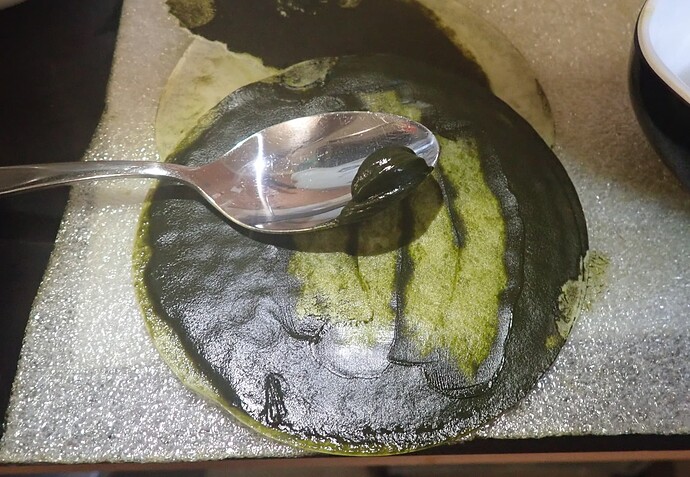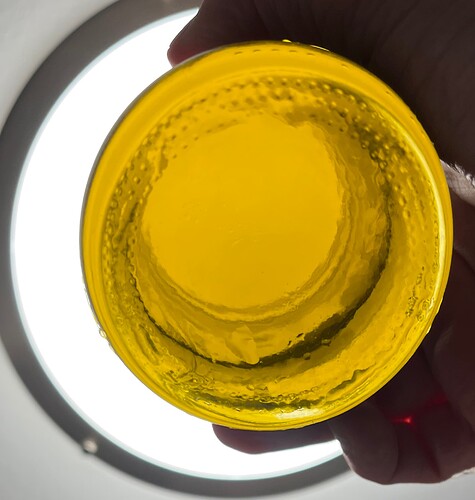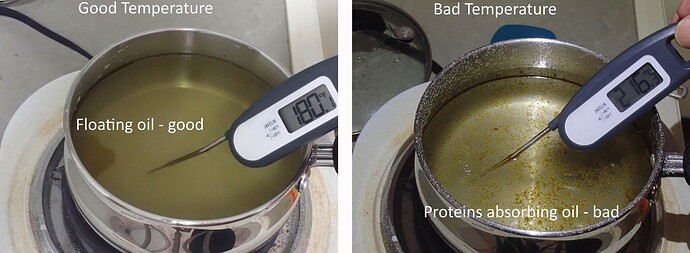I’ve had at TLC kit on the shelf for a year. Yeah, gotta break it out and start testing at home. Been avoiding the learning curve fuckups. I make enough on projects that matter…
Or that uv light and somereagents. You might enjoy playing around with that aswell…
Wait till you get some magic dirts ordered
70:30 ethanol water? I did try that, photon advised against it because of the loss in affinity. Despite this, I tried it and it didn’t go very well. Took a long time to filter and there was a fair amount of loss.
Thank you. You saved me a lot of time.
Circling around to @beaker s post, I came across his post following up on a protein-in-the-mix problem. This is probably totally new to this forum. Plant Proteins are a scourge that fuck up the final oil. Commercial processors are not affected as bad due to better source material and chemical/mechanical filtering. It hasn’t really been addressed at home, but it needs to be. Most RSO boils this and water soluble crap into the oil. And as you know, washing with Alcohol extracts a lot of non-targeted plant material. Alcohol does a number on the proteins by breaking hydrogen bonds, causing the proteins to unfold, exposing hydrophobic surfaces, IE non-polar surfaces, that then bond to other proteins, and in our worst case, the targeted non-polar cannabinoids. That’s why I posted the pic above of the dark green KN95. I purposely left out the paper towel so you’d see what one drop of Citric Acid/L will create. As I mentioned, the non-polar cannabinoids are hijacked by bonding to the protein and this seems to increases over time. I left one jar sitting overnight and had a horrible yield. Safe to say, 15-20 minutes settling time is good enough, then run it through a filter. Here’s an interesting picture showing a lot of protein after a 24 hour winterization (using an alternate approach called Isoelectric Focusing via pH shifting). I ate some once and got my ass kicked.
The amount of protein dissolved depends on your source material, if its busted up, wet, dry, room temp, and the ABV of the alcohol. If you want to test this, take 1oz, crush it in a mason jar, wash with Isopropyl for 10 minutes, strain off the biomass, then add 1 drop of lemon juice and shake. A green head or sediment forms. Most common is the white floc that forms which @beaker was seeing, “green gunk and also the wax”. It’s probably the secret formula behind this video -
You wont be able to see through the jar. Interesting crossroad right here. The human eye can see particulates down to around 20-30 microns. N95/KN95’s are 95% efficiency down to 0.3um, 99.5 efficent at 0.75um and above. Best part, they’re fast flow. (Toss out your coffee filters!) So, if you can see it, an N95 can stop it. This works perfectly for snagging coagulated proteins. The jar will be crystal clear.
Back to the problem, protein becomes a major polluter in RSO. It’s presence in brine is worse. Proteins go through two phases in the presence of salt. Low salt concentrations raise proteins solubilty, high concentrations lower protein solubility. The “Salting-Out” of the proteins make them ball up and absorb non-polar compounds. I see it as black tar sands shifting on the bottom of the pan and have poured so many runs down the drain, not knowing what I was looking at. its not an emulsion, its looks like black sand. The catalyst to this balling up is temperature. Proteins start salting-out, IE, becoming non-soluble in water, starting out around 190f. You can see the progression from 180f up to 212f. Ultimately the proteins will ball up tightly and sink to the bottom of the pan as black sand when the water cools.
Fortunately, I’ve found this is somewhat reversible. Adding Citric Acid breaks up the oil/protein bonds, allowing the oil to dispurse across the water surface. In the back of my mind, I see a possible extraction process of salting-out proteins, letting the oils bind, harvesting the sands, then using acid to free the oils. Interesting rabbit hole…
Article on Portein Denaturation
Article on protein coagulation
https://www.tandfonline.com/doi/full/10.1080/10942910600596340
Undoubtly problematic if that’s all you do. Temperature, pH, salinity, changing polar conditions, all must be monitored with the addition of water in the process. Every step is impacted. Soon, I’ll publish the OP to show every step and how to mitigate losses. Its turns out not to be bad. Winterization is a major culprit in reducing yield. “Silting” as I call this hybrid degumming, has low impact on losses if done quickly to avoid denatured proteins bonding with cannabinoids.
80/20 methanol water should do the trick, you can get away with minimal cooling, but I’m told chilling a bit is also helpful. 80/20 is a common extraction solvent for analytical labs because of its selectivity!
I’m scared to work with that stuff
I’m surprised the brine makes the protein coagulation worse, since the denaturation that exposed hydrophobic residues (making it water soluble) could be undone, and the protein would change conformations to be hydrophilic once an environment (like hot brine) was introduced. Because ethanol and water are relatively close in polarity, I figured the protein isn’t too far in the other direction.
I’ve always done my water washes (not brine) at 80C (176F) so I just got lucky I suppose! Really incredible work!
Are you on the commercial scale? If so, and you have some spare equipment, you can handle it rather safely. If you are siphoning from drums/carboys instead of pouring I figure that’s fine.
On the home scale, it’s a bit more troublesome. The best way to be safe with solvents like that is keep them cold and sealed, but it’s also easy to blow up your freezer since most are not explosion proof!
Personal/Medical Use, I would do some outdoor nonsense if I were to use it and I would have dry ice on hand. I still don’t like how you can go blind and how it’s toxic to the liver from accidental ingestion… Pentane and hexane are the other two I don’t like either. Pentane seems too touchy with the Flashpoint issues and everything I read about hexane is a last resort if you can’t find heptane and it’s stupid hard to purge out.
Distilled Whip-It Premium 420ml Premium and Extractohol Ethanol are the only two things I’m okay with using for now.
I’m switching to Isobutane at some point because I hear it’s the shyt. I also want to get some heptane denatured ethanol and try some experiments.
I’m okay with working with isopropyl and acetone as well I just don’t like to. I never worked with acetone. I’ve only ever used isopropyl for cleaning rigs…
Fair enough on all points. You can do all things certified organic (I do!), and if you can’t handle these things safely, don’t. I’d be curious what you could do with acetone.
Heptane isn’t that hard to purge with a vacuum pump and a hot plate though.
Curious, what did @Photon_noir mean by ‘loss in affinity’?
When you add water your alcohol becomes more attracted to water than oils. Loses affinity for cannabinoids as you add water.
Ah, okay, emulsions for louching. This is really a big problem in the petroleum industry to separate crude oil from water. There are two emulsions that occur - Water in Oil and Oil in Water. The two are quite different and must be broken to recover the oil. What @Photon_noir is talking about is the “Oil in Water” case. Want to separate the oil? Add Salt. Isopropyl Alcohol/water bonds are disrupted by “Salting-Out” the alcohol. This is easy with Isopropyl, whereas, Ethanol salts-out using Potassium Carbonate.
https://projects.ncsu.edu/project/chemistrydemos/Organic/SaltingOut.pdf
That’s a whole can of worms because Potassium Carbonate (K2CO3) blows up the pH to 10+. This is one of the reasons I focused the RSO 2.0 OP around ISO. Its much easy to maintain a neutral pH. Check out this video of distilling with a brine solution. As the Isopropyl boils off, it leaves non-polar oil droplets in a polar solution so the droplets coalesce into larger drops on the surface. Eventually the alcohol is gone leaving oil and water repelling each other.
Great, no? Resins ready for a water bath and final reduction.
With Brine, the rising salinity as the alcohol boils off causes the proteins to progress from a Salt-in phase to a Salt-Out phase. Its this Salt-Out phase where the proteins gobble up the oil like pacman. I’m beyond my pay grade here, but what I think happens next to proteins exposed to acid, is a continued denaturing or breakdown into amino acids, thus releasing the bonded cannabinoids. That’s my observation and why I call it partially reversible. I can get some oil out of the black sands.
Hmm. A lot of interesting data to parse, and I’m not sure we can reach a definite conclusion. I’m not so sure there are hydrolysis reactions occurring at these conditions, mainly because most hydrolysis of esters/amides require much stronger acids than what you have. You are at high temperatures and the salinity may be helping, but still unlikely upon first glance (feel free to correct me!) Salinity is an important factor for protein folding, but pH is just as, if not more important and I think that’s what we’re seeing (ie going in and out of solution). That’s one possibility.
I also see a similar type of substance when doing water washes (the ‘bad temperature’ photo). While it looks like waste, it may actually be a water in oil emulsion; I do a water purge/decarb/devolatilization after my water wash to prep for dewaxing at 120C for 1hr under vac. At the start, there is always this scummy looking material stuck to the flask, but once the water is gone I have a smooth looking oil. In your case it could be mono/diglycerides (products of acid degumming) causing water to emulsify into your RSO. If you can, take a sample of the scummy material if you have it and heat it, under vacuum if possible, or in your oven at ~120C. If it returns to your RSO consistency, then that may be your answer (plus a way to increase yield ![]() )
)
Proteins, being polymeric materials, can also be directly removed by ultrafiltration with no need for flocculation.
just not with an N95 mask…
and why are we getting (hypothesizing?) significant protein in a ethanol extraction to begin with.
Proteins were produced by fed-batch fermentation of Saccharomyces cerevisiae cultivated on date solution. Protein content was 52.5% (dry basis). Protein solubility was studied as a function of pH, NaCl concentration, and solvent. The minimum protein solubility was at pH 4 and the maximum was at pH 12. As a function of NaCl concentration, protein solubility was 647.6 g/kg for 1 M. The best solubility was 916.3 g/kg under pH 12 and 1 M NaCl. Solubility was very low, 2.1 g/kg, when ethanol was used as a solvent. Biomass was dried by air drying, vacuum drying, and freeze drying. The best solubility of 937.5 g/kg was obtained using freeze and vacuum drying methods.
https://www.tandfonline.com/doi/full/10.1080/19476337.2010.543472
I guess going to the trouble of opening ALL the cells up (and hence diluting the ethanol) might get you more proteins, but I’m dubious.


